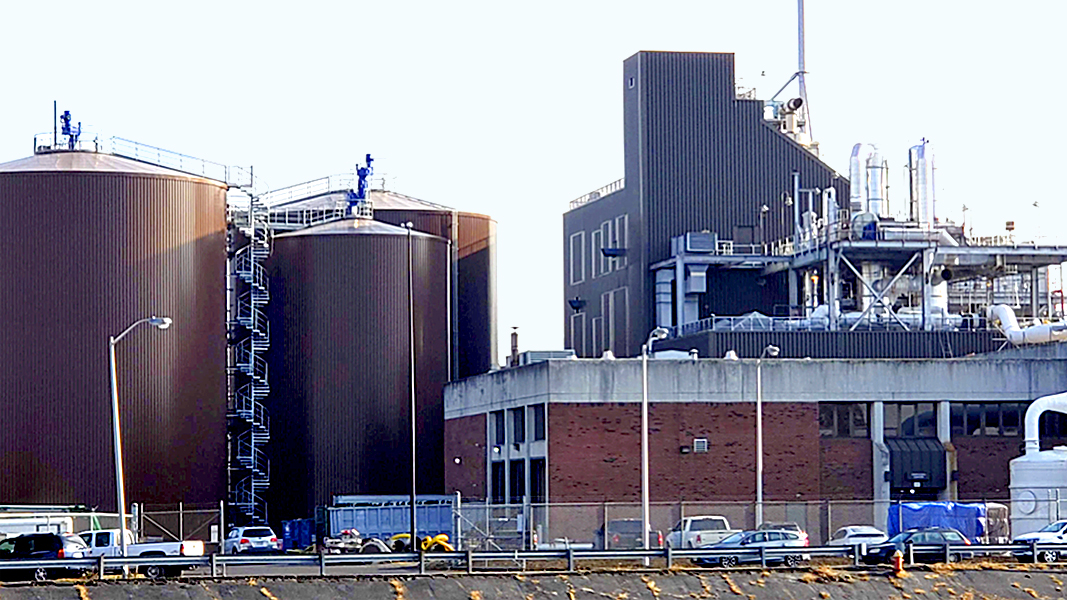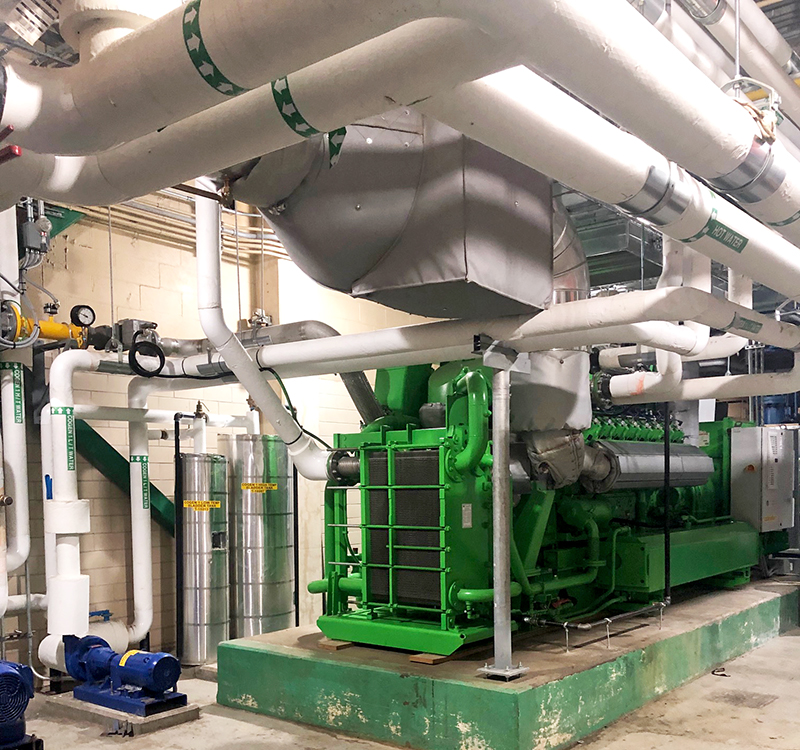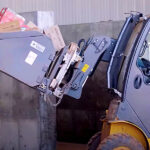Nora Goldstein
Trenton Biogas, operated by Trenton Renewables (Trenton Renewable Power, LLC), is a dedicated food waste anaerobic digestion facility with depackaging capabilities located in Trenton, New Jersey. After many years of permitting, engineering, procurement and financing, the plant began operating in late 2019. It has the capacity to process 400 tons/day of commercial, municipal, industrial, and agricultural food waste streams, and features three 1.2 million gallon digesters and three 1.1 MW combined heat and power (CHP) engines.
The facility is housed in a previously abandoned sewage sludge plant on Duck Island in Trenton that was built in 1992. The original plant was never used and Trenton Biogas received approval in 2014 from the New Jersey Department of Environmental Protection (NJ DEP) to retrofit the site to support food waste recycling via anaerobic digestion. It has a lease-purchase arrangement with the City of Trenton and three other municipalities that jointly own the site (Hamilton, Ewing, and Lawrence).
“This facility is unique,” notes Brian Blair, Trenton Renewables’ General Manager. “It was constructed 30 years ago to receive biosolids in giant hoppers that were installed in the floor. We saw the opportunity to retrofit the hoppers to accept packaged and unpackaged food waste streams. As a result, incoming feedstock flows directly off the truck and into our system, leaving no opportunity for putrescible food waste to touch the floor of the receiving area.”
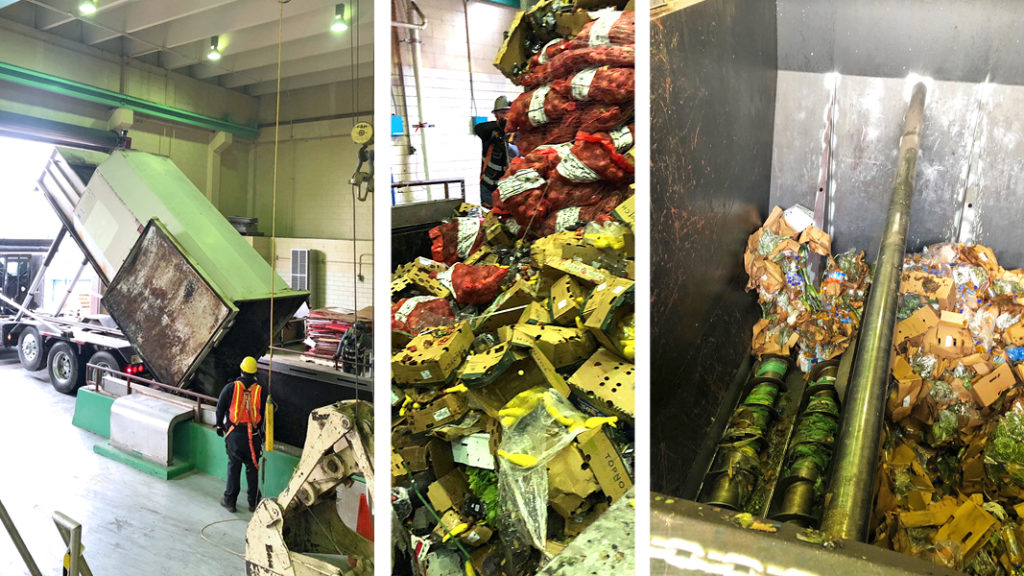
Trucks tip directly into receiving hoppers. Feedstocks pass through crushers, screens and magnets ahead of depackaging. Photos courtesy of Trenton Renewables
Trenton Biogas obtained a source separated Class C solid waste recycling permit from NJ DEP; all pre and postconsumer food waste can be accepted, including the organic fraction of household waste, along with food processing residuals (seafood, poultry, bakery, beverages, etc.), horse bedding, and soiled paper. “Up to 10% of our volume can be metal or plastic containers, foil, cling wrap, and other packaging materials that our system automatically separates for recycling or upcycling on their own,” explains Andrew Johnston, Marketing Director. “We built the facility to remove all friction from food waste recycling and, ultimately, that means meeting the market where it is and being responsive to what our customers need. As a result, our receiving area can accommodate any kind of vehicle delivering any kind of food waste in any kind of format. And beyond our regular feedstock agreements, part of our capacity is reserved for spot market and trial loads with new customers to make sure we continue to learn and refine our approach to diverting food waste from landfills and incineration.”
Facility Design And Operations
Trenton Renewables worked with Symbiont, an EPC (Engineering, Procurement, Construction) contractor to design the facility to its specifications. It licenses a novel technology from a Danish company for the depackager and anaerobic digesters. (Trenton Renewables declined to provide details.)
Unloaded food waste goes through a “barrage” of pretreatment steps, including crushers, screens, and magnets, to prepare it for depackaging, explains Blair. “The metal is salvaged and remaining material is prepared into a precise size and consistency. This facilitates separation of the plastics and organics in the depackager. We also added a process for separating grit out of the slurry before it goes into the digester to remove glass and other hard, dense material.” An on-site lab analyst takes stream samples of the slurry to help optimize management of the AD process.
Retention time in the thermophilic, continuous stirred digesters is approximately 31 days, after which the digestate is run through a centrifuge and ammonia is stripped out of the liquid fraction to produce ammonium sulfate, a commodity traded as an agricultural fertilizer. After ammonia removal, liquids are discharged to the municipal sewer system. The solids (approx. 23,000 tons/year), which have gone through pathogen reduction via thermophilic treatment in the digesters, are held at the plant until they cool down and any ammonia is released. “The building is under negative pressure and the air is treated through a biofilter,” adds Blair. “The nutrient-rich solids can be composted, e.g., mixed in with leaf waste, and we’re collaborating with composters who have been looking for a locally-generated material like this. We’re particularly excited about several niche markets that we’ve discovered recently, which use solids with no amendments.”
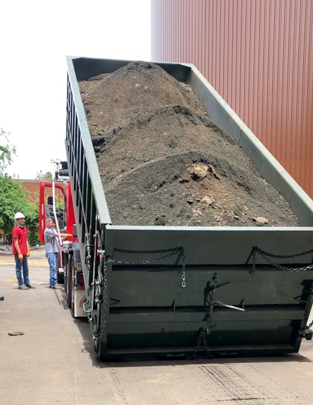
About 23,000 tons/year of nutrient-rich solids are produced. The company is collaborating with composters to further process the material, and is exploring niche markets that can use the solids with no amendments.
He notes that the presence of microplastics in the end product, generated by the preprocessing and depackaging steps, is a challenge. Trenton Renewables is refining a system to remove them on the back end of the process. “It’s a nuance of the industry that’s yet to be solved sufficiently to meet our goals,” says Blair.
The three CHP engines can produce 27,000 MW/year. Heat from the engines warms the digesters and a fraction of the power is used to operate the plant. “The remaining power is contributed to the grid,” notes Johnston. “Our electrons are registered with PJM, a regional transmission organization that coordinates the movement of wholesale electricity. Our meter is bi-directional, allowing us to measure every kWh we supply to the surrounding area. Trenton Renewables is exploring power purchase agreements (PPAs) with several of the companies recycling their food waste with us, as well as entering into PPAs with nearby towns.”
The company is getting ready to commission several more digesters (1 million gallons each), which would add another 200+ tons/day of capacity and create the ability to export renewable natural gas (RNG) by leveraging its already designed and approved membrane conditioning system. While the current climate has limited Trenton Renewables to operating at approximately 60% of its permitted capacity, this additional capacity will enable it to continue to grow with its customer base, particularly as the New Jersey food waste recycling law goes into full effect later in 2021. The law requires large food waste generators (defined as generating over 52 tons/year of food waste) within 25 miles of a food recycling facility to separate and recycle food waste.


